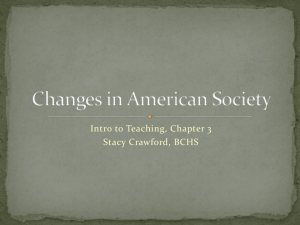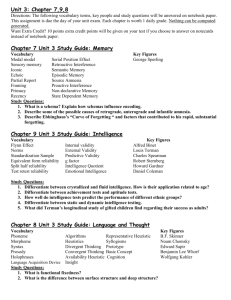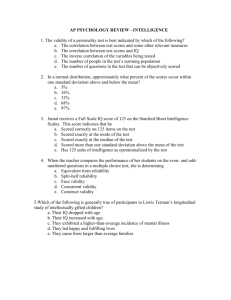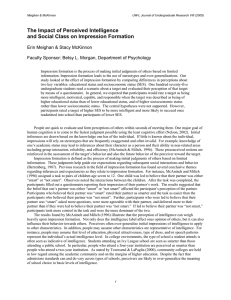PowerPoint Presentation - EDP 650 Diversity
advertisement
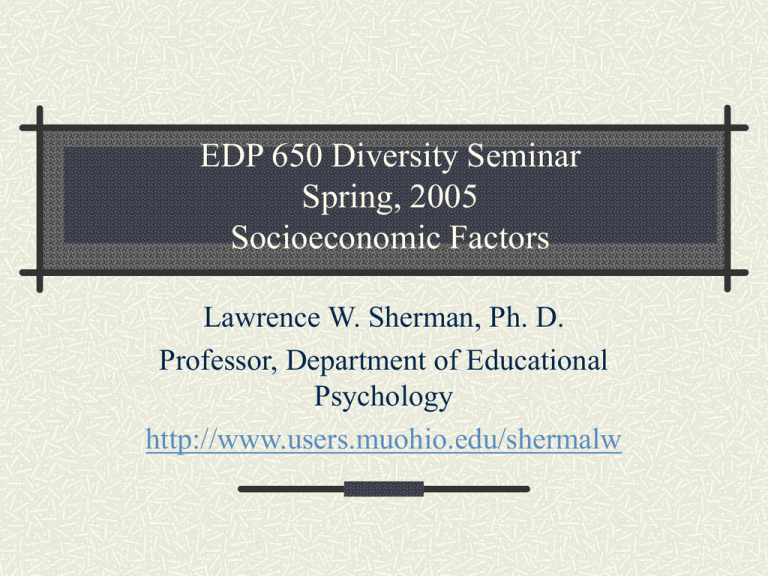
EDP 650 Diversity Seminar Spring, 2005 Socioeconomic Factors Lawrence W. Sherman, Ph. D. Professor, Department of Educational Psychology http://www.users.muohio.edu/shermalw The British Scene: Late 19th to early 20th Century cousins Sir Francis Galton Sir Charles Darwin r regression correlation (Pearson-Product Moment Correlation) Charles Spearman: H. Carl Pearson Nephew of Galton Factor Analysis Validity Pearson Product Moment Correlation Coefficient Primary medium or index of validity. Three important forms of Validity •Predictive Validity •Concurrent Validity •Construct Validity Related definitions of “Validity” • The state, quality, or fact of being valid in: • • • • law or in argument, proof, authority, etc. Social Darwinism (Spencer) Late 1800’s early 1900’s Nurture vs. Nature battles Justification for maintaining power British Empire at turn of the century Validation of the use of power “White man’s Burden” Wealth and Privilege Social Class Intelligence Many different approaches to defining the construct: Good overview in February, 2003 issue of APA Monitor, Volume 34, No. 2 Intelligent Intelligence Testing Breaking New Ground Intelligence Across Cultures! Essence of G: Scientists search for the biology of smarts. ScienceNews, February 8, 2003, Vol 163, No. 6, pages 92-93. Validation of Intelligence I As Construct Validity Should Predict Achievement (Predictive Validity) Why? Benet’s Initial original mission: “identifying children with mental retardation” Strong Statistically Significant correlations between “Intelligence” and “Achievement” obtained (usually in the .50 to high .60’s) Validation of Intelligence II As Concurrent Validity. Many “Intelligence” tests are correlated (r) with each other: e.g.,: WISC with Stanford Binet and vice-a-versa Kaufman with each of the above All are good predictors of School Achievement ACHIEVEMENT Intelligence Test scores Second strongest predictor of Achievement test scores! Usually in the .50 to .60’s range! Socioeconomic Status (SES) First and strongest predictor of Achievement test scores. Usually in the high .70’s and above range! Proxy Variables Dictionary definition: “The authority to act for another” One variable might substitute for another Is Intelligence also Achievement? Are they the same? Do they measure the same things? Might one be a “proxy” for another? Socioeconomic Status (SES) “The generic idea is that all known complex societies are characterized by one or more forms of institutionalized social inequality. However, there are variations between societies and presumably, within a society over time in the degree of opportunity, that is, the extent to which persons are recruited or assigned to roles bearing unequal rewards on the basis of the circumstances of birth or rearing in a particular family, locality, cultural or enthnic group, or social milieu. To the extent that achievement depends upon such circumstances over which the individual has little or no control, we say that a society is stratified.” (Duncan, Featherman, & Duncan, (1972). Socioeconomic Background and Achievement. New York: Seminar Press. Measurement Scales of SES Miller, D. (1977). Handbook of Research Design and Social Measurement (3rd edition). New York: Longman. A good general source: Duncan’s Socioeconomic Index (SEI) U.S. Census Socioeconomic Status Scores Hollingshead’s two factor Index of Social Position Warner Index of Status Characteristics Variables Usually Included in Measures of SES Father’s Education (head of household) Father’s Occupation (head of household Number of Siblings Income Example of Father’s level of education: 7. Graduate Professional training Standard College graduate Partial college training High school graduation Partial high school Junior High school Less than 7th grade 8. Hollingshead 2 factor scale (7 education levels) 9. His occupations also have 7 levels from Higher Executives (1) to unskilled laborer’s (7) 1. 2. 3. 4. 5. 6. Duncan’s analysis of Turner’s data .90 Ambition index .27 Family Background .23 .19 .06 Class Values Index .15 .46 .92 .12 .37 .11 IQ School SES rating .12 .87 Turner (1964) Interpretations Family Background affects ambition Ambition affects both IQ and Class Values Lesser direct influences are: Family background to class values IQ IQ and class values In discussing the relationship between Family Background and School SES ratings, he notes that “families may choose their place of residence,” but he also concedes that “by introducing neighborhood, we may only be measuring family background more precisely.” Turner, R. H. (1964). The Social context of ambition. San Francisco, CA: Chandler Press. Equality of Educational Opportunity Report (1966): “Coleman Report” James Coleman is a “Sociologist”. Research examined the predictors (correlations) of School Achievement. Primary correlates predicting school achievement scores included: Socioeconomic index (Duncan’s SEI) Destiny Control (similar to Locus of Control) Racial composition (proportions) of school districts, primarily African Americans to Whites proportions aggregated data. Implications of Coleman Report in the 1970’s to 1990’s Desegregate American Schools: Redistricting Busing Community Control Full Inclusion classrooms (PL 94-142, and later IDEA legislation). At the Higher Education Level, “Affirmative Action” Richard Hofmann’s Research on Ohio Proficiency Test Scores While Hofmann does not use the term SES, his construct, “Poverty,” is strongly related. He uses a combination of three of the 1990 U.S. Census variables to define a “Community Poverty Index:”. % of adult high school dropouts, % of single parent homes, % of school age children receiving welfare (ADC). Over a 11 year period of time, the Community Poverty Index derived from 1990 U.S. Census data continued to be The strongest and statistically most significant predictor of 1990 to 2000 Ohio Proficiency Test pass rates, with correlations being in the high .70’s and low .80’s, predicting 2000 pass rates as well if not better than 1990 pass rates. The Present: 2003 Last year President Bush celebrated the one year anniversary of the “No Child Left Behind” legislation signed off at Hamilton Ohio, 2002 Nation still concerned with effective schools! Accountability and “Standards” based reform. The Present: 2003 Higher Education U.S. Supreme Court decision on University of Michigan Law School’s Affirmitive Action plan last summer (July, 2003). Analysis of Texas and California Universities after they do away with Affirmative Action. Some conclusions: The statistical tool, Pearson Product Moment Correlation, r, has historical significance for inter class validation issues: If Biology (nature) then what? If Environment (nurture) then what? Social Class and Social Stratification continue to be a problem for education and our American society in general. “Gaps” in achievement and SES among diverse populations are not being overcome, but rather widening! Stephen Jay Gould, 1996: “Mismeasure of Man,” p. 28 “…resurgences of biological determinism correlate with episodes of political retrenchment, particularly with campaigns for reduced government spending on social programs, or at times of fear among ruling elites, when disadvantaged groups show serious social unrest or even threaten to usurp power. What argument against social change could be more chillingly effective than the claim that established orders, with some groups on top and others at the bottom, exist as an accurate reflection of the innate unchangeable intellectual capacities of people so ranked?


